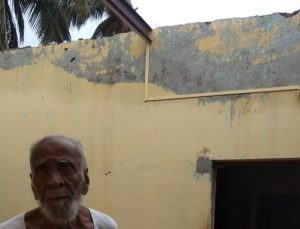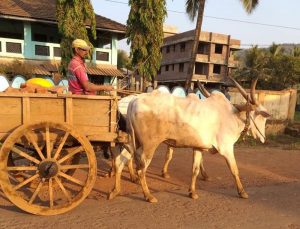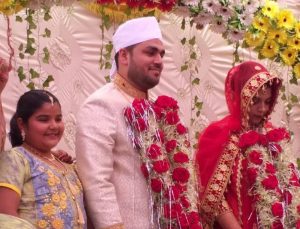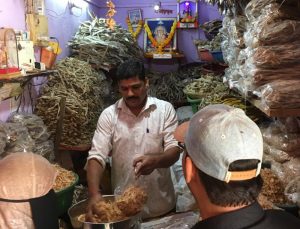Mansoor Jaffer
Reflections of a Habshi Yemeni Kokni Batavian African
Cyclone Nisarga blustered through our ancestral village Borli early in June, leaving behind a trail of destruction.
It ripped off the roofs of some houses, uprooted mango, beetle nut and coconut trees and severely damaged the electricity infrastructure. Thankfully, it did not claim the lives of any Borlikers.
The villagers, including a few dozen descendants of our great grandfather Jaffer Murtuza, are slowly picking up the pieces.

Tikkie Mamoe Chogle in the front room of his roofless house in Saigoan
Borli was not the only place that felt the destructive wrath of the mighty Nisarga. The Cyclone set off from the heart of the Arabian Sea before unleashing its ferocity along the west coast of Gujarat and Maharashtra. Nisarga meted out harsh treatment to some of Borli’s neighbouring villages such as Morba, Saigoan, Shrivardhan and Sarwa, from where many Cape Town families originate.
Even in the remotest village some folks have smart phones and they shared pictures of the cyclone’s destruction with their families 8 000km across the Ocean. One of the saddest images is of a forlorn 85-year-old Tikkie Mamoe Chogle standing in the front room of his roofless home in Saigoan. The old man is the brother of the late Ayesha Allie, who was married into the family that ran R Allie and Sons in Lansdowne Road Claremont for many years.
Rekindling childhood memories
This episode rekindled childhood memories of village stories. It got me to pull out the laminated family tree as well as to go through the notes that record our visit to Borli in 2011.
It prompted a reflection on our roots. DNA tests have firmly placed us in the East –both the Indian subcontinent and the Indonesian Archipelago. The story of the latter is for another day because its history is a lot more complex. It dates way back to the 16th century and the inhuman slave trade practised by European powers shattered family and social connections.
Borli is at the centre of a group of villages collectively called Borli Panchatan with a combined population of 6 000. This may sound like lots of people for a group of small villages, but we are talking about India here. Our village is in the State of Maharashtra that is home to more than 124 million people. There are 29 States in India. The largest is Uttar Pradesh, the population a staggering 234 million. Christians, only 2.5% of the total population, are 30 million in number while 172 million Muslims represent a mere 14% of India’s 1.3 billion people. So then, in this context Borli Panchatan is really a small place.

A borliker steers his oxwagon
The village is situated in India’s Konkan region whose roots are a mix of Konkani people and Arab traders who had travelled to the Western coastal belt long before the advent of Islam. The geographical area largely overlaps the pre-colonial Janjira Habsani State that was ruled by Abyssinian (Ethiopian) Siddhis from the 11th century. The Habsanis, which comes from Habshi that means Abyssinian and the Koknis are mostly the same people. I therefore use the terms interchangeably.
The Yemen Connection
I recently discovered that the Arabs came mainly from Yemen, as that was the first place of habitation of most Arabs in the Middle East. If I were prone to superstitions, then the Yemen connection would really have propelled my mind into overdrive. My father returned home alone from his pilgrimage to Mecca in 1961 after his mother Ayesha died and was buried in Aden, Yemen. At the same time, Soeker Arnold was based in Aden, working as a medical assistant for the British Royal Air Force. He was there with his wife Hajira and two children Kayzuran, three, and one year-old Abdurahman. Hadjie Soeker became my father-in-law 23 years later when Kayzuran and I married in Cape Town. He recalls the pilgrims coming through Aden at the time and remembers attending the funerals of several South African Hujaj. Now I discover the Yemeni were in the Konkani region as well, making us the progeny of Yemeni, Konkani, Habshi and Batavian people. Yemen now looms large in our history.
In the nineteenth century, most of the Koknis eked out a living from fishing and agriculture. Desperately poor because of the wholesale plunder and atrocities committed by British colonialism as well as facing a massive grain shortage, many Koknis sought opportunities in far off lands, including South Africa.
After their arrival in Cape Town in the late 1800s and early 1900s, the Habsanis/Koknis mainly became small traders and set up societies that raised funds to build schools and clinics back home.
I can only try and imagine what Borli was like in the 1850s or 1860s when Jaffer Murtuza came into this world. We do not have much detail on his life except that he eventually had five children – four boys and a girl. Around the turn of the century, his son Yusuf Jaffer Murtuza headed to South Africa by ship in search of greener pastures. He left behind his two wives and two sons, Jamalsab and Shabodien.
The name Murtuza fell away somewhere along the line – no one quite knows why, when or how. He married Ayesha Safodien and in 1920, this union produced a son Hassan, our father. They lived in a wood and zinc house in Doringhoogte, now known as Thornhill in the greater Athlone area. Our father was just five years old when Yusuf Jaffer departed this world, a few years after the collapse of the Ottoman Empire and before the onset of the great depression.
Twenty years later Hassan married Raghmatunisa Desai and the two of them had six children – Yusuf, Suleiman, Adam, Zuleiga, Zubeida and me – who in turn bequeathed their parents 17 grandchildren, 24 great-grandchildren and three great-grandchildren. One of my mother’s friends calls us her tribe.
Silent emotions as we arrive in Borli

A family wedding in the village a few years ago.
In 2011, we visited the village for five days as part of a six-week long tour of India. My third or fourth cousin fetched Kay and I at the Mangaon railway station after our ten-hour train journey from Goa. It had been a wonderful ride in which we saw amazing sights that included majestic Catholic church buildings from the Portuguese era and a huge cow resting in the midday sun on the platform of an otherwise empty Ratnagiri train station.
As night broke, we drove into the village that my grandfather left as a young man more than a century ago. I worked through the emotions in silence, thinking about what life was like back then and the experiences Yusuf Sahb endured on the long, sometimes perilous journey to a foreign land.
There were language barriers but the family treated us very well, especially at meal times. I drew from childhood memory to understand some of the Kokni words and phrases such as Kya ghabr hai which means how are you and Kya boltas (what are you saying?) or Kya kurtis (what are you doing?). When you really were stuck, you would just shake your head Indian style and say achchaa (good or it is good).
You feel completely foolish repeating the same few phrases repeatedly while your head sways from side to side, placing undue pressure on your occipital bone. But the family were delighted that we tried. They would break into broad smiles when we said khana bahut achchaa (the food is very good, or something like that).
Modernity and tradition meet
Modernity and tradition meet in Borli. It has one small main road with a few shops selling sweet meats, clothes and groceries. Opposite the run down internet café is a deep well where women collect water and carry it in buckets on their heads. People from the smaller surrounding villages come to Borli to shop. Many head to the local fish market to get fresh fish. A few ox-wagons ramble down the side roads alongside the odd 4×4 van with the ever-present cows wandering slowly in the most unexpected places. We watch as a father arrives at the school opposite the family home with four children on his small motorbike.

The fish market in Borli
We sit on the stoep at night watching the moon and listening to voices coming from the nearby streets. Kay chats with Mia Ahmed, the 90-year-old grandfather of the family. She in English, he in Kokni one of the 780 languages and the Lord knows how many thousands of dialects in India. He seems to be asking questions. He looks at her and then at me. In the end, he answers his own questions. “Aah, Malaysia,” he exclaims pointing at Kay and looking at me for some kind of confirmation. He had figured out her supposed origin or ethnicity that had clearly been the source of his curiosity. Mia Ahmed, who passed away at the age of 94, had been married to Zainab, whose grandfather was Mahmood, brother to our grandfather Yusuf Jaffer. She and her siblings took on a variation of their father’s first name Usmansaab as a surname. Two of her brothers Razak and Mahmood Osman ran various Campwell stores in Cape Town from the 70s.
My sister in law Razia had put us in contact with her cousin Abdusamad and his family. They invited us for a meal and treated us like royalty. They were of modest means and lived in a tiny home. Kay and I sat at the table in the front room while Abdusamad, may he rest in peace, positioned himself on the adjoining bed. He watched us like a hawk to ensure we did justice to the meal. His long red beard gave him a sense of authority and his gentle smile the power of persuasion. It is incredible how people who have little derive so much joy from giving.
The inter-village cricket tournament
The day before we left for Mumbai, I attended an inter-village cricket tournament as a special guest. A fellow made announcements over a makeshift PA system and curiously, he gave me about seven titles, which ended with Africa. The others were Mansoor Hassan Jaffer Murtuza Sahib and another, which I do not recall. I felt a bit awkward being in a shorts and a t-shirt because it appeared I was supposed to be one of the VIPs present. Organisers asked me to toss a coin at the start of one of the games but I did not know heads from tails on a rupee coin. My third cousin twice removed helped me. A big dispute broke out between our village captain and the officials during a game. Whatever the cause of the tiff, it did not help us because we lost the game and that was the end of the tournament for us.
The highlight of the afternoon was when a car pulled up on the side of the grandly named Borli Royal Cricket Grounds. A smartly dressed man sporting dark glasses alighted from the passenger side. He looked like some Bollywood star as he slowly walked towards us, his hair blowing in the gentle wind. It was Mukhtar, our second cousin, who had come to visit from South Africa. Mukhtar came to South Africa in the 90s, working in various Campwell stores, ending up as manager of the Town Centre branch in Mitchells Plain. One can never predict where you may land one day. Your journey starts in Borli and somehow takes you to the Town Centre in Mitchells Plain, Cape Town.
One afternoon we went to visit Abdul Hamid, my last remaining cousin in Borli. He was the son of my father’s brother Shabodien. He had been bedridden for more than 12 years following a stroke. We stood quietly at his bedside for some time. His eyes appeared to light up as relatives explained our family connection. It was an important visit. Abdul Hamid died about a month later.
We returned home in early 2012 after a journey that was truly memorable. India changes the way you look at the world. It was a huge education and strengthened our connection with our history.
The Habsanis/Koknis in Africa
Today, the Kokni/Habsani community in the Cape is around 40 000 and growing. They include Sondays, Gires, Uldes, Parkers, Khans, Mowzers, Breys and numerous other families. Many among their number have made huge impacts on South African society. The Janjira Habsani Educational Society highlights some of their contributions:
In 1999, a Habsani, Shauket Fakie, became the country’s first black Auditor-General; During apartheid, a Habsani Abdulla Abbas, led non-racial rugby; A Habsani, with fellow Capetonians, scaled Kilimanjaro in 2004; A Habsani, Bibi Dawood of Worcester, was a treason trialist with Nelson Mandela in 1956; The first Muslim woman to be detained in the Cape was a 22-year old Habsani; A Habsani was a torchbearer in the Athens 2004 torch relay.
The 22-year-old detainee was my sister Zubeida and the torchbearer my mother Raghmatunisa.
Communities are not only made up of heroes and saints though. Among the ranks of the Habsani/Koknis have been some scoundrels, collaborators and general no goodniks.
The trip to India had made us think more deeply about our roots. While there are many who tend towards ethnic essentialism, my own understanding is that all of us have hybrid identities. In our case, we have Indian, Yemeni and Abyssinian roots as well as a strong connection to the Indonesian Archipelago.
There is no such thing as a pure race, ethnic group or culture. So maybe I am an African-Batavian –Yemeni-Borliker or a Batavian-Habshi-Yemeni- Kokni-African. The permutations are endless. I fully embrace all the tributaries of my heritage and am proud of it.
Back in the Cape, the family is still growing. Like many families, we are a motley collection of diverse individuals and characters that include business people, mechanics and doctors, comedians, ex soccer players, teachers and chancers, musicians, writers, wannabe singers, freedom fighters, builders, engineers, accountants and cooks.
Picture Jaffer Murtuza riding slowly along a gravel road outside Borli on an ox-wagon 160 years ago. Gazing into the future, he could not possibly have imagined a future with a big tribe of his descendants settled along the Southern-most tip of Africa.
Mansoor Jaffer is a cultural activist, musician and writer











